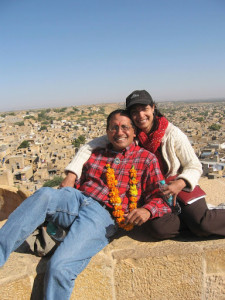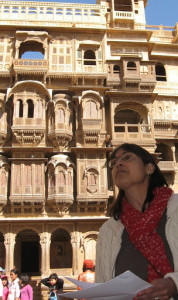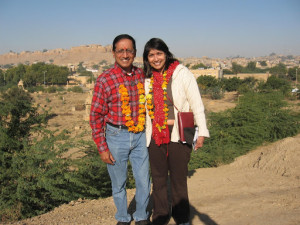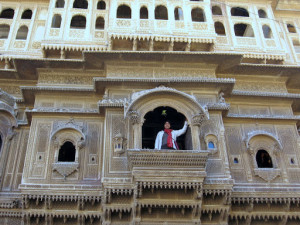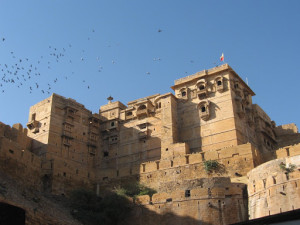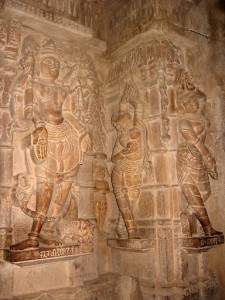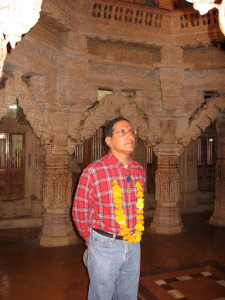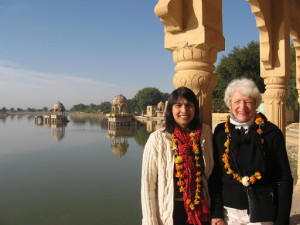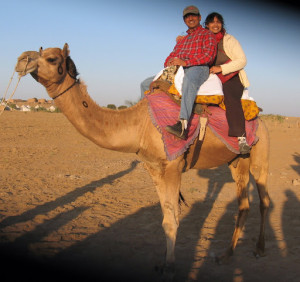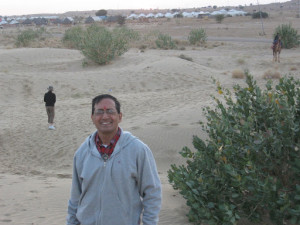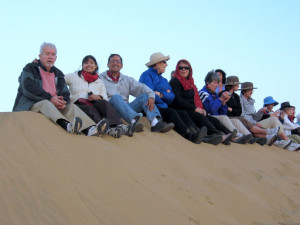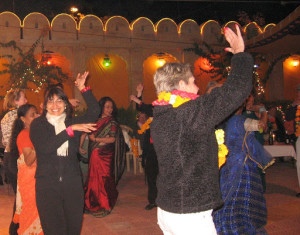Surveying a Stop on the Fabled Grand Silk Route
In my early twenties, I had left a piece of my heart in Jaisalmer, for like the unknown carvers who, down the ages had etched lacey patterns on yellow sandstone havelis, so too the town had etched its lasting presence upon my consciousness. When I did arrive in Jaisalmer, after more than twenty years, I found that little had changed. Time hadn’t entirely stood still; but it had limped into the twenty-first century, still carrying vestiges of its medieval past in its wake.
Jaisalmer Fort (above right) seems to rise out of the golden sands of Rajasthan’s Thar Desert like a mirage—suddenly and quite inexplicably. Mile after endless mile of shrubby plains and near-desert ambience give way to a hulking fortress that overlooks a thriving town. The townsfolk still seem untouched by the magical pull of their city that sits on the ancient Silk Route from China and Mongolia to Mesopotamia and Persia. Indeed across the barren landscape of yellow sand dunes and undulating winds, caravanserais laden with the merchandise of past ages such as carpets and opium, spices and teas, crossed from one curve of the globe to the next. Marauding bandits helped themselves liberally to the spoils of such trade, swelling their coffers in the bargain and spending their ill-gotten wealth on the hiring of skilled craftsmen for the creation of exquisitely carved havelis or courtyard homes that stand today as silent symbols of a time when labor was cheap and plentiful and aesthetic sensibilities ran unleashed upon a bewitched prosperous people.
Hidden Havelis, Crumbling Fortresses, Placid Lakes:
To see the remnants of such artistry, one needs only to stroll through the narrow streets of the walled town to tour such stone concoctions as the Patwon Ki Haweli (above), home of a prominent merchant and Nathmal Ki Haweli where the ornmanetal jharokas or balconies display particularly fine carvings. Indeed, like all visitors, I gasped at the minute attention to detail that brought lace-like delicacy to stone columns and canopies, doorways and walls, screens and balconies. They seem to stand like the piped frosting on a tiered wedding cake, mirroring the delicacy and fragility of such fairy-tale confections. A few of them are open to the public and converted today into small commercial establishments to prevent them from falling under the hotelier’s control. Though I winced at the unabashed commercialism of these homes-turned-shops, I could not but admire the determination to preserve them as homes—the sort of zeal that has converted country estates in Great Britain into deluxe hotels and turned their gardens into upscale shops.
Once inside the vast complex of Jaisalmer Fort, it was the twin carved sandstone Jain Temples (ab0ve) that stunned me. Built in the 16th and 17th centuries by the town’s wealthy traders, the temples exert such an attraction that I found it impossible to tear myself away from the precincts of this sacred space that has remained unchanged in centuries.
Posing for pictures along the heights of the fort’s ramparts, we looked down upon the city of Jaisalmer, snoozing quietly in the pale sunshine. Shades of yellow as far as eye could see–tints of sunflowers and corncobs, hues of honey and buttercups–bedazzled as the famous ‘sonar patthar’ or golden stones of Jaisalmer gleamed beneath us.
I was grateful that the guide took us to Gadisagar Lake (left) first thing in the morning when the cenotaphs of the many royal ladies who once bathed upon the ghats or steps that border the placid lake created a quiet sense of contemplation in that post-dawn light. Here, the spirit of Jaisalmer whispers quietly for it presents the quintessential vista—a combination of lake and umbrella-domed cenotaph, sandstone carvings upon shallow steps and the story of courtesan named Thelia who defied the powers-that-be by building a brazen gateway leading to the lake that later she converted into a temple by placing upon it the statue of her favorite god.
In Camel Saddles Toward the Sam Sand Dunes:
When the sun sank low on the horizon entering into the troubled reaches of next- door Pakistan, we made our way to the Sam Sand Dunes on camel back (left). To get to the dunes, we rode in a bus on a stark desert road punctuated only occasionally by low growing shrubbery. Camels waited patiently to take their impatient passengers on the half hour amble towards the crescent shaped dunes that lay faintly outlined against the pearl-streaked horizon. A thimble of tea and a couple of biscuits consumed in the midst of the Thar Desert seem almost an incongruity today, but we were treated to just such a cuppa surrounded by the flapping white tents that form part of the romance of the camel safaris offered by astute tour operators.
Before settling down on the sand dunes at Sam (left) to see the sun disappear over the salmon-tinged horizon, I did my good deed for the day, exchanging, as a favor for a local vendor, a dollar that he had received as payment from an American tourist and giving him forty handsome rupees instead. The sight of the smile that enlightened his face was worth its weight in gold—the poor lad had no idea just how many Indian rupees he ought to have received and the sheer trust with which he put the money in my hand and received Indian currency in exchange taught me a lesson or two about the refreshing lack of guile in our mostly corrupt world. It was little acts of kindness performed quite spontaneously, in this fashion, that remain engraved in my memory; for the pleasure I received in return from the gratitude that was writ large upon innocent faces warms, even today, the cockles of my heart. Now I know why I left my heart in Jaisalmer twenty years ago.
That evening, we were treated to a cultural fest (above) at Fort Rajwada, a new temple to commercialism situated in what seemed like the heart of the desert. There, under the stars, we danced with agile Rajasthani women who abandoned the strictures of purdah to give us a tutorial on the art of shaking one’s head without moving one’s neck while keeping time to rustic folk music produced by earthy drums and stringed instruments. We were invited to join the gyrating women in a circle that exploded with the sounds of clapping and foot stomping and drum beats as drinks were sipped and appetizers circulated. An hour later, we sat at long tables to enjoy a buffet dinner that included Rajasthani specialties.
It had been a long day but the combination of experiences—sights, sounds, tastes, smells—had made it flash by in a blur. Jaisalmer is being gradually discovered by the Western tourist and the town is gearing up to enjoy its new-found celebrity. Were Mick Jagger, whom I had met in Jaisalmer twenty years ago, a visitor in the town today, he might not find himself so easily able to blend in with the local turban-sporting populace.
(To continue to follow us on our journey with the Palace on Wheels, please click on the Jodhpur link).
Bon Voyage!
